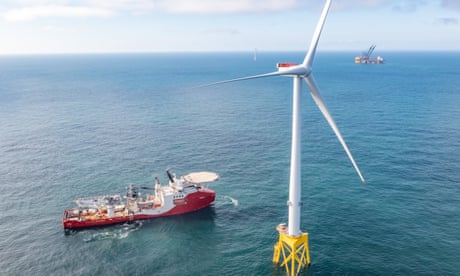S teve Wilson is a little windswept after stepping off a rocking boat in choppy North Sea waters. Wilson is programme director of Seagreen, Scotland’s largest offshore windfarm, which this week began producing power. Wilson has just sailed an hour out to sea from Montrose, in Angus on the east coast of Scotland, with other local, interested parties.
There, they witnessed a technician hop aboard one of the first turbines to feed power back to the mainland. A drone operator onboard protested about conditions that made it tricky to send up the machine. “We did deliberately decide to build it somewhere windy,” Wilson laughed after landing safely back on shore.
The £3bn Seagreen project, a joint venture between SSE Renewables and France’s TotalEnergies, is located 27km (17 miles) off the Angus coast. The first turbine of 114 was connected to the electricity network in the early hours of Monday morning. The project promises to generate 1.
1 gigawatts of electricity – enough to power about 1m homes – in its first phase. That’s equivalent to about 60% of Scotland’s current offshore wind output. Its debut provides a rare bright spot for Britain’s energy supply as gas shortages in Europe have threatened to spill over into blackouts in the UK this winter and even higher bills for consumers .
However, the windfarm will not be fully operational until some point in the first half of next year. “It’s unfortunate it’s not a short-term fix, but the long-term fix really is to deploy as much low carbon generation as we can,” Wilson said. Ultimately the developers hope the site will produce enough renewable electricity to power 1.
6m households. That would in theory cover two-thirds of Scottish households. However the electricity generated – which connects into the network via a substation near Dundee – will be distributed around Great Britain.
The turbines at the huge project have a maximum tip height of 187 metres (613ft), about twice the height of the Elizabeth Tower, which houses Big Ben. While floating windfarms are planned for further out to sea , Seagreen will be the world’s deepest fixed-bottom windfarm – its deepest foundation is due to be installed at 59 metres below sea level in December. “This is a significant project that’s very technologically innovative for the renewables industry.
We’re installing a windfarm at a very difficult site with complex, rocky conditions,” said Wilson. The construction involves “suction bucket” technology for the bright yellow wind jackets, or foundations, which were assembled at the nearby Port of Nigg. It is more than a decade since the rights to the seabed were granted by the crown estate, which manages the royal property portfolio.
TotalEnergies agreed with SSE Renewables to acquire a 51% stake in Seagreen in June 2020. Wilson said the approval process has been slow going, with torrents of data and information required in the consent process. “That’s a key focus for us in the future – trying to really reduce that time period, quite significantly, in order to support accelerating building offshore wind in Scotland and the UK.
” He adds that the energy security strategy, issued in April, shows “government agencies are starting to get aligned on it”. Seagreen’s location just south of the oil and gas capital of Aberdeen is symbolic. Local cabbies and hotel owners in the Granite City are hopeful that a shift to renewables can keep the region prosperous in the long term.
Sign up to Business Today Free daily newsletter Get set for the working day – we’ll point you to the all the business news and analysis you need every morning Privacy Notice: Newsletters may contain info about charities, online ads, and content funded by outside parties. For more information see our Privacy Policy . We use Google reCaptcha to protect our website and the Google Privacy Policy and Terms of Service apply.
SSE Renewables is part of London-listed SSE group, which is investing £12. 5bn over five years in green projects in its “net zero acceleration programme”. SSE’s chief executive, Alistair Phillips-Davies, has attempted to offer a solution to the current energy crisis, accelerated by the war in Ukraine, which has pushed up bills.
Over the weekend, he proposed a voluntary scheme through which generators of non-flexible, low-carbon power such as wind and nuclear could sign up for contracts to deliver non-hedged output at a fixed price, helping to reduce consumer bills. The merits of this solution were underscored this week when it emerged that the collapse of Bulb could end up costing taxpayers £4bn due to the government’s decision not to hedge. The surging price of gas has also sharpened the focus on renewable energy.
Over the past week, gas for delivery the next day has cost £432 per megawatt hour, nine times higher than the £48MWh agreed at the last contract-for-difference auction round, analysis by climate information site Carbon Brief found. Ed Miliband, Labour’s shadow climate change and net zero secretary, told the Guardian that the rise in gas prices was further evidence that the “transition to cheap, clean, homegrown power” needed to be accelerated. “But instead the Conservative leadership candidates have turned their backs on wind and solar, leaving households exposed to higher bills and our country’s energy system insecure,” he said.
“This economic illiteracy is just the latest act in 12 years of failed Tory energy policy. Their shortsightedness has been staggering – closing our gas storage facilities, failing to insulate houses and blocking the quickest, cheapest renewables – and it’s households across the country who are now paying the price. ” For the sake of consumers, government officials will be hoping for more blustery days off the shores of Scotland.
.
From: theguardian
URL: https://www.theguardian.com/environment/2022/aug/23/throwing-the-switch-on-scotlands-largest-offshore-windfarm
